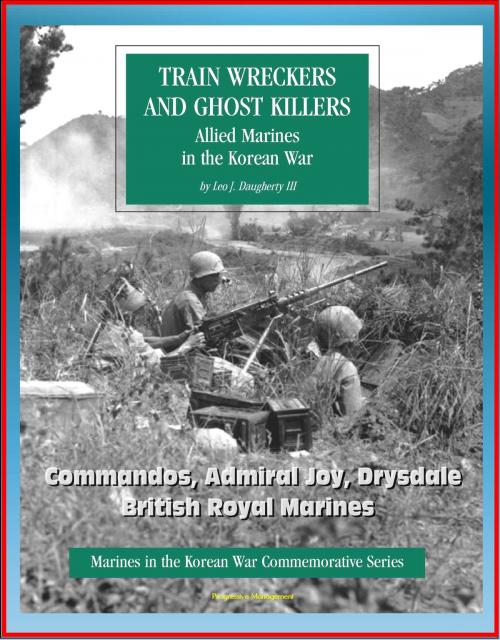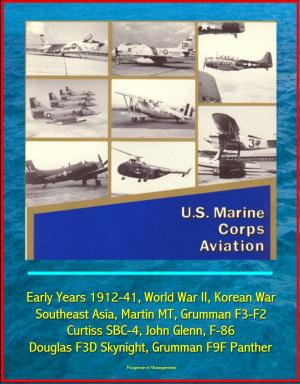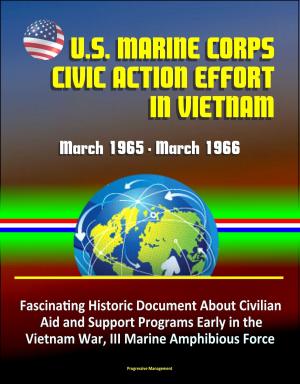Marines in the Korean War Commemorative Series: Train Wreckers and Ghost Killers - Allied Marines in the Korean War, Commandos, Admiral Joy, Drysdale, British Royal Marines
Nonfiction, History, Asian, Korean War, Military| Author: | Progressive Management | ISBN: | 9781301195633 |
| Publisher: | Progressive Management | Publication: | January 5, 2013 |
| Imprint: | Smashwords Edition | Language: | English |
| Author: | Progressive Management |
| ISBN: | 9781301195633 |
| Publisher: | Progressive Management |
| Publication: | January 5, 2013 |
| Imprint: | Smashwords Edition |
| Language: | English |
In the early morning hours of 25 June 1950, mechanized and ground units of the North Korean Peoples' Army (NKPA) rolled across the 38th Parallel into the neighboring Republic of Korea (ROK). Within 48 hours, President Harry S. Truman placed U.S. forces in Japan on alert. Within a week's time, elements of the U.S. Eighth Army, then on occupation duty in Japan, were rushed to South Korea to stem the North Korean invasion. As army soldiers, and later Marines of Brigadier General Edward A. Craig's 1st Provisional Marine Brigade, fought the NKPA to the outskirts of the port of Pusan, the United Nations undertook a series of votes that not only condemned the North Korean invasion, but brought thousands of allied troops to the assistance of the beleaguered ROK. Among the troops assigned to the Korean theater was a hastily assembled unit of Royal Marines stationed in Great Britain and Malaya, where they were already engaged in a guerrilla war against Communist terrorists.
The deployment of Royal Marines to Korea came as the government of Prime Minister Clement R. Attlee announced its intention in the British Parliament to add to the forces being sent to Korea. While there was some disagreement with this decision among the Chief of the Imperial General Staff, Field Marshal Viscount William Slim, and Chief of the Air Staff, Marshal Arthur W. Tedder, both of whom argued that "Britain was already engaged in active operations in Malaya as important ... in countering communist expansion as in Korea," Admiral Lord Fraser of North Cape, the First Sea Lord, strenuously advocated for the dispatch of a brigade-sized force of Royal Marines to operate in unison with the U.S. Navy as a commando raiding force. Within two weeks of Lord Fraser's decision, on 16 August 1950, a 300-man Royal Marine unit was formed and took the name 41 Independent Commando. "Independent" in the unit designation meant the commanding officer had sole responsibility for the unit and did not have to consult higher British headquarters on operational and logistical matters.
The commandos were drawn mostly from active duty units and individual Marine reservists preparing to depart for service in Malaya as part of 3 Commando Brigade. Under the command of Lieutenant Colonel Douglas B. Drysdale, a seasoned Marine veteran who had served with distinction as a member of 3 Commando in the Far East during World War II, 41 Independent Commando began preparations for service in Korea.
The Marines assembled at the Royal Marine Barracks at Bickleigh, Devon, site of the commando school, where they received the customary inoculations and issue of uniforms prior to their deployment to the Far East. Initially, 41 Commando drew from three separate contingents. The first, organized from volunteers and reservists in the United Kingdom, was flown from Bickleigh to Japan in civilian clothes to conceal the ultimate destination and employment. The second group comprised volunteer sailors and Marines drawn from the British Pacific Fleet. This group already had begun an intensive period of training even before the main body of Royal Marines arrived from Great Britain and had been organized into a rifle section known as the Fleet Volunteers. The third group came from a reinforcement draft destined for 3, 40, 42, or 45 Commando in Malaya and was on board the British troopship HMT Devonshire, which had been diverted to Japan in early August. Vice Admiral C. Turner Joy, Commander, Naval Forces, Far East, and Admiralty officials in London and Washington, D.C. decided the Royal Marines would operate with the U.S. Navy and Marines.
In the early morning hours of 25 June 1950, mechanized and ground units of the North Korean Peoples' Army (NKPA) rolled across the 38th Parallel into the neighboring Republic of Korea (ROK). Within 48 hours, President Harry S. Truman placed U.S. forces in Japan on alert. Within a week's time, elements of the U.S. Eighth Army, then on occupation duty in Japan, were rushed to South Korea to stem the North Korean invasion. As army soldiers, and later Marines of Brigadier General Edward A. Craig's 1st Provisional Marine Brigade, fought the NKPA to the outskirts of the port of Pusan, the United Nations undertook a series of votes that not only condemned the North Korean invasion, but brought thousands of allied troops to the assistance of the beleaguered ROK. Among the troops assigned to the Korean theater was a hastily assembled unit of Royal Marines stationed in Great Britain and Malaya, where they were already engaged in a guerrilla war against Communist terrorists.
The deployment of Royal Marines to Korea came as the government of Prime Minister Clement R. Attlee announced its intention in the British Parliament to add to the forces being sent to Korea. While there was some disagreement with this decision among the Chief of the Imperial General Staff, Field Marshal Viscount William Slim, and Chief of the Air Staff, Marshal Arthur W. Tedder, both of whom argued that "Britain was already engaged in active operations in Malaya as important ... in countering communist expansion as in Korea," Admiral Lord Fraser of North Cape, the First Sea Lord, strenuously advocated for the dispatch of a brigade-sized force of Royal Marines to operate in unison with the U.S. Navy as a commando raiding force. Within two weeks of Lord Fraser's decision, on 16 August 1950, a 300-man Royal Marine unit was formed and took the name 41 Independent Commando. "Independent" in the unit designation meant the commanding officer had sole responsibility for the unit and did not have to consult higher British headquarters on operational and logistical matters.
The commandos were drawn mostly from active duty units and individual Marine reservists preparing to depart for service in Malaya as part of 3 Commando Brigade. Under the command of Lieutenant Colonel Douglas B. Drysdale, a seasoned Marine veteran who had served with distinction as a member of 3 Commando in the Far East during World War II, 41 Independent Commando began preparations for service in Korea.
The Marines assembled at the Royal Marine Barracks at Bickleigh, Devon, site of the commando school, where they received the customary inoculations and issue of uniforms prior to their deployment to the Far East. Initially, 41 Commando drew from three separate contingents. The first, organized from volunteers and reservists in the United Kingdom, was flown from Bickleigh to Japan in civilian clothes to conceal the ultimate destination and employment. The second group comprised volunteer sailors and Marines drawn from the British Pacific Fleet. This group already had begun an intensive period of training even before the main body of Royal Marines arrived from Great Britain and had been organized into a rifle section known as the Fleet Volunteers. The third group came from a reinforcement draft destined for 3, 40, 42, or 45 Commando in Malaya and was on board the British troopship HMT Devonshire, which had been diverted to Japan in early August. Vice Admiral C. Turner Joy, Commander, Naval Forces, Far East, and Admiralty officials in London and Washington, D.C. decided the Royal Marines would operate with the U.S. Navy and Marines.















